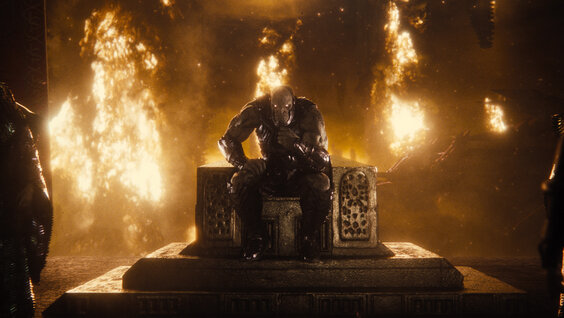Zack Snyder's Justice League
As Zack Snyder's Justice League winds through its long opening credits, the list finally reaches the spot of screenwriter and names only Chris Terrio, making no mention of Joss Whedon, co-writer of the film’s 2017 theatrical cut and the uncredited co-director who stepped in when Snyder left the production to attend to a family tragedy.
It’s a fitting omission, as the rest of this four-hour extended version is one giant middle finger to Whedon and the mirth, brevity, and competent storytelling he brought to his surprisingly respectable patch-up job.
Cleansed of the MCU-indebted humor, visual clarity, and respect for viewers that broke from the brooding superheroes and bleak aesthetic of Man of Steel and Batman v Superman: Dawn of Justice — which James Wan (Aquaman) and Patty Jenkins (WW84) further distanced themselves from post-BvS — the fan-demanded #SnyderCut doubles down on his DCEU films’ core tenets, presumably giving his supporters exactly what they want.
So be it.
The ultimate vanity project, Zack Snyder's Justice League is as vindictive and self-indulgent as moviemaking gets — the work of a director so lost in his personal interests that the level of egotism would be impressive if the film itself wasn’t so poorly made.
Granted free reign, the result is a supercut of Snyder’s worst tendencies — a combination of 300’s slo-mo excess, Sucker Punch’s miscalculated “fun,” and the interminable final hour of Man of Steel, all realized via shoddy, under-lit video-game special effects.
The project is wholly his, to the point that unaltered clips from Justice League feel like oxygen masks dropping from a tailspinning airplane’s overhead compartments. So disgusted is Snyder with Whedon’s version that he completely changes the look of villainous Steppenwolf, outfitting him with metallic armor resembling a rejected character from Gods of Egypt, and scrambling his voice so that it’s unclear whether Ciarán Hinds or AI should receive payment.
As for Steppenwolf’s backstory as an alpha badass, returning to Earth to avenge his fluke defeat at the hands of an unprecedented alliance of tribes and gods, it’s flat out deleted. For mysterious reasons, he’s now doing new alpha badass Darkseid’s bidding as an indentured servant — a bizarre bit of ambiguity considering the tendency of Zack Snyder's Justice League to overstate practically every other detail.
Whereas Justice League takes one, maybe two minutes to explore a piece of information like Steppenwolf’s motivation, Snyder’s cut takes four or five minutes, piling exposition upon exposition until every angle is explored and stripped of all intrigue...not that there was all that much left to the imagination before. At the same time, Snyder removes concise scenes that convey much through a few lines and gestures, yet also keeps or extends bland exchanges that ironically say less in their newly bloated form.
Many lines by Justice League comic relief Barry “The Flash” Allen (Ezra Miller) remain intact, but the #SnyderCut’s questionable new editing rhythm and frequently intrusive score by Junkie XL (in place of Danny Elfman’s far more tasteful work) render them oddly humorless in the name of sustaining the longer film’s hyper-serious tone.
Arthur “Aquaman” Curry (Jason Momoa) suffers a similar comedy-free revisionist fate, down to the excising of his accidental encounter with the Lasso of Hestia, belonging to Diana “Wonder Woman” Prince (Gal Gadot), whose once dynamic action scenes are largely devoid of energy under Snyder’s joyless guidance.
Scenes with Bruce “Batman” Wayne (Ben Affleck) generally stay the same, though the backstory of Victor “Cyborg” Stone (Ray Fisher) is twisted into a soap opera that recasts his original one-note presentation as a frustrating series of starts and stops. The unified heroes’ attempt to resurrect Clark “Superman” Kent (Henry Cavill) is also significantly expanded and adds an new layer to Barry’s abilities, but Snyder’s overlong execution of this more complex Kryptonian jump-start makes one pine for the streamlined quality of Whedon’s cut.
While the big final battle remains sloppy and the few major changes just further drag out the inevitable, it’s Snyder’s handling of the would-be post-credits scenes that’s truly baffling. Following a drastically different yacht-set conversation between Lex Luthor (Jesse Eisenberg) and Deathstroke (Joe Manganiello), the film jumps right to a pandemic-filmed, future-set scene that’s easily one of the most poorly shot and written sequences in blockbuster history. In addition to shoddy lighting and cheap-looking CGI, Affleck eerily resembles George Clooney and Jared Leto’s Joker sounds like Jim Carrey might actually be the one beneath all that makeup.
The filmmaking casts serious doubts on Snyder’s current talents, but lest there be any doubt regarding his jackass status, he places a cover of “Hallelujah” over the end credits — a childish kiss-off to anyone who dared dislike his adaptation of Watchmen (easily his best film) and made fun of its divisive love scene, infamously cued to Leonard Cohen’s original.
The assault on good taste at last complete, there’s a reactionary desire to never see future Snyder films, but though that feeling will likely subside with the hope that all this morose grandeur is behind him, there endures the not-so-minor victory that the DCEU is at long last rid of his toxic vision.
Grade: D-minus. Rated R. Available to stream via HBO Max
(Photos: HBO Max)






